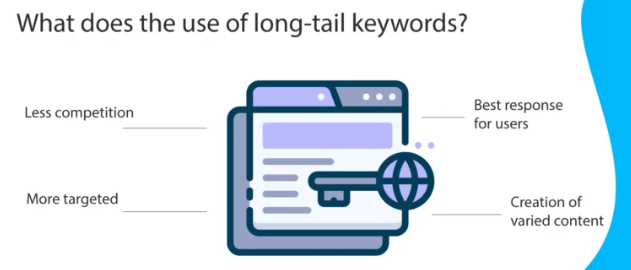No Widget Added
Please add some widget in Offcanvs Sidebar
SEO is like a jungle. Competition is fierce and only the relevant and important sites hold the reins. In this competitive environment, if you target general terms to position your niche site, you reduce your chances of appearing in the first search results. So what can you do to stand out from the crowd and gain a higher ranking in the SERP? You need a good keyword strategy.
Keyword research remains a cornerstone of any successful SEO campaign. When your site does not yet have a high level of authority, it is best to choose relevant and specific terms. Find keywords with a low level of competition. Although they have a lower search volume, they allow you to generate qualified traffic and increase your conversion rate.
Would you like to know all about the advantages of using the right words for your site’s natural referencing?

The SEO long tail is a visibility strategy that enables you to position yourself on search engines. It includes the use of relevant and specific terms resulting from combinations of three or more words.
It is based on a low-competition key expression that web users use to refine their search for content on the web. The long query allows users to formulate their intentions clearly.
In other words, this concept is opposed to generic keywords, which are competitive keywords. It enables you to rank your site favorably in search results.
Let’s say you’re developing an e-commerce business. You sell dresses, and your main keyword will be “dress“. That’s pretty broad and generic. However, to target and reach a given audience, you can exploit relevant terms such as :
As you can see, the long tail, by definition, refers to niche keywords. It targets a market segment, reaches a specific audience and presents them with relevant products.
The long tail is an SEO strategy for positioning a website in the SERP to generate potential traffic. It’s a solution that can be particularly beneficial for your site’s visibility. Why should you do this?
Because choosing specific terms means targeting the relevant queries that people search for when they want a precise result. You position yourself on the keywords on which Internet users can find you. This can sometimes generate more traffic to your web pages or blog posts than the main keyword. What’s more, long queries are less competitive.
You can therefore position your website easily in the first Google search results with the long tail SEO. Last but not least, using specific key terms helps you to target the right people. The result? You find qualified traffic and increase your customer conversion rate.
Niche keywords are useful in SEO, but also in paid search. When you use long expressions for your Google Adwords campaigns, you get much lower costs per click (CPC) because the competition is low. In other words, buying specific keywords is cheaper than buying general terms, which are expensive and highly competitive. You get a good return on your investment because your Adwords advertising generates a large number of potential customers.
Long tail keywords add value to your brand’s visibility on the web. When you include them in your SEO strategy, you optimize your chances of appearing on the first pages of Google searches. Why is that?
Note that it’s not the same thing to position yourself on the key term “ballet dance“, which has 12,100 search volumes, and “ballet classes“, which has 720. Or “adult ballet classes“, which has 260 search volumes. (Data collected on Ubersuggest).
The SEO long tail is certainly a way of ranking and generating qualified traffic, but it has one major drawback. It has a fairly low search volume. This can often affect the number of visitors to your site.
Bear in mind, however, that this problem does not arise in all cases. If, for example, you are targeting a specific product that is very much in demand in your sector of activity, you won’t have to worry about traffic to your shop window.
So you need to master the best tools and tricks for finding the right words for your niche. This is even more important when your site is not yet popular. Once you have succeeded in your word search, you can work on your key terms by creating quality content.
There are many proven methods for identifying long tail keywords. Let’s take a look at the best keyword research tools right now.
Type a potential keyword you want to rank for into the Google search box, and you’ll see a drop-down list of related keywords searched for by Internet users. You can also add any letter after your key search term to get more interesting suggestions.
Finding SEO long tail expressions is simple. The hard part is knowing how to use them in the content of your web pages. So how do you do it? Discover the three-step method you need to put in place.
Long-tail keywords have a high search volume but not much competition. They are also called "organic" keywords because they are generated by users who don't need to be advertised or promoted.
You can use a keyword planner tool like Keyword Planner to find long-tail keywords for your business or niche. Then you need to choose the right keyword that is most relevant for your business or place and use it in your content creation process.
The long-tail keyword is a keyword that is not in the top 10 most searched keywords. For example, if you are looking to find content on "how to get a job as an IT consultant," you can use the keyword "how do I get a job as an IT consultant."